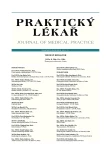The attitudes of general practitioner’s regarding physical activity promotion
Authors:
R. Šlachta
Authors‘ workplace:
Vedoucí katedry: Mgr. Zdeněk Hamřík
; Fakulta tělesné kultury
; Katedra rekreologie
; Univerzita Palackého, Olomouc
Published in:
Prakt. Lék. 2012; 92(3): 153-157
Category:
Of different specialties
Overview
The promotion of physical activity in the primary care setting has been shown to be a promising approach to encourage sedentary populations in a number of countries to be more physically active. General practitioner’s (GP’s) have reasonable potential to help to increase the population’s level of physical activity.
However, the results of such an initiative are also dependent on the GP’s attitudes towards the promotion. A questionnaire survey was used to determine the knowledge and attitudes of Czech GPs regarding physical activity promotion in their settings. The results suggest that GPs have a generally good level of knowledge of the health benefits of regular physical activity. Some doubts were revealed regarding the GP’s information about diagnoses where the positive influence of physical activity was only recently approved (rectal and breast cancer, Alzheimer’s disease).
Distrust that patients would accept their recommendations was shown to be the greatest barrier preventing them from encouraging patients to be more physically active.
The answers given in response to optimal regime of physical activity for the patients confirm some gaps in GPs knowledge regarding the physical activity promotion issue. The awareness shown by GPs regarding the importance of PA promotion can be considered as a good starting point for the development of system similar to “Exercise on prescription” known from northern countries in Czech Republic. However questionson how and who should start the initiative to motivate GPs to be more involved in physical activity prescription remains unanswered.
Key words:
prevention, intervention, primary care, population approach, knowledge, information.
Sources
1. Biddle, S., Fox, K., Edmund, L. Physical activity in primary health care in England. London: Health Education Authority, 1994.
2. Bouchard, C. Physical activity and health: introduction to the dose-response symposium. Med. Sci. Sports. Exerc,2001, 33, p. 3487-3500.
3. Bouchard, C., Blair, S.N., Haskell, W.L. Physical activity and health. Champaign IL: Human Kinetics, 2007.
4. Daďová, K., Radvanský, J., Pelíšková, P. a kol. Je preskripce pohybové aktivity součástí léčebně-preventivní péče civilizačních chorob? Výsledky dotazníkového šetření lékařů. Čas.Lék. čes. 2007, 146, s. 503-507.
5. Health Education Authority. Promoting physical activity in primary health care – guidance for primary health care team. London: Health Education Authority, 1996.
6. James, D.V.B., Crone, D., Curry, N. et al. Report on the evaluation of the South Staffordshire Physical activity care pathway pilot (short version). University of Gloucestershire, U.K., 2010.
7. Kallings, L.V., Leijon, M., Hellénius, M.L. et al. Physical activity on prescription in primary health care: a follow-up of physical activity level and quality of life. Scand. J. Med. Sci. Sports, 2008, 18, p. 154-161.
8. Lawlor, D.A., Keen, S., Neal, R.D.Increasing population levels of physical activity through primary care: GPs’ knowledge, attitudes and self-reported practice. Fam. Pract. 1999, 16, p. 250-254.
9. Máček, M., Máčková, J. Pohybová aktivita jako prevence vzniku rakoviny. Med. Sport.Boh.Slov., 2004, 13, 3, s. 145-152.
10. Němcová, H.Doporučené postupy pro praktické lékaře.Pohybová aktivita v prevenci civilizačních chorob. [cit. 2011-12-5].Dostupné na WWW:http://www.cls.cz/dp.
11. Oja, P., Borms, J. Health enhancing physical activity. Oxford: Meyer & Meyer Sport Ltd, 2004.
12. Pastucha, D., Sovová, E.,Malinčíková, J. a kol.Pohybové aktivity jako součást prevence kardiovaskulárních onemocnění vordinaci praktického lékaře.Prakt. lék., 2010, 90(8), s. 466-469.
13. Physical activity guidelines advisory committee.Physicalactivity guidelines advisory committee report. Washington, DC: U.S.Department of Health and Human Services, 2008.
14. Professional associations for physical activity.Physical activity in the prevention and treatment of disease.Elanders: Swedish national institute of public health, 2010.
15. Sallis, R.E.Exercise is medicine and physicians need to prescribe it!Br. J. Sports Med.2009, 43, p. 3-4.
16. Sorensen, J.B., Kragstrup, T., Skovgaard, T. et al. Exercise on prescription: a randomized study on effect of counseling vs counseling and supervised exercise. Scand. J. Med. Sci. Sports, 2008, 18, p. 288-297.
17. Stejskal, P. Proč a jak se zdravě hýbat. Břeclav: Presstempus, 2004.
18. WHO.Global strategy on diet, physical activity and health.[online]2004. [cit. 2011-12-12]. Dostupný na WWW:<http://www.who.int/dietphysicalactivity/strategy/eb11344/strategy_english_web.pdf>
Labels
General practitioner for children and adolescents General practitioner for adultsArticle was published in
General Practitioner

2012 Issue 3
Most read in this issue
- Testicular microlithiasis
- Nursing interventions in home care
- The influence of ageing on cognitive functions and their evaluation in general practice
- General practitioner and rehabilitation
